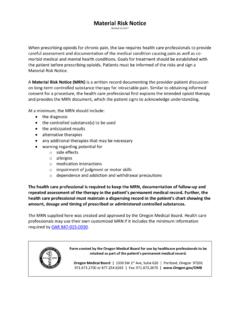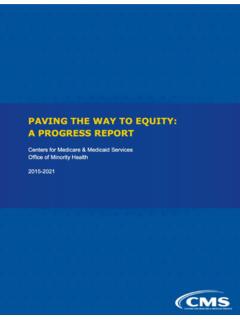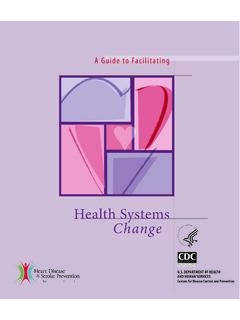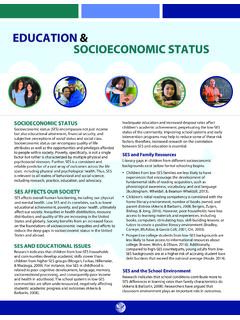Transcription of Public Health Terminology - Oregon
1 Oregon Health Authority Page 1 Public Health Terminology Public Health Terminology (including descriptions of federal agencies that fund Public Health programs) Access Access is the potential for or actual entry of a population into the Health system. Entry is dependent upon the wants, resources, and needs that individuals bring to the care-seeking process. The ability to obtain wanted or needed services may be influenced by many factors, including travel, distance, waiting time, available financial resources, and availability of a regular source of care. Access also refers to the extent to which a Public Health service is readily available to the community s individuals in need. Accessibility also refers to the capacity of the agency to provide service in such a way as to reflect and honor the social and cultural characteristics of the community and focuses on agency efforts to reduce barriers to service utilization.
2 Source: Turnock, BJ. Public Health : What It Is and How It Works. Jones and Bartlett. 2009. Assessment Assessment is defined as: 1. Collecting, analyzing, and using data to educate and mobilize communities, develop priorities, garner resources, and plan actions to improve Public Health . 2. One of the three core functions of Public Health , involving the systematic collection and analysis of data in order to provide a basis for decision-making. This may include collecting statistics on community Health status, Health needs, community assets and/or other Public Health issues. The process of regularly and systematically collecting, assembling, analyzing, and making available information on the Health needs of the community, including statistics on Health status, community Health needs, and epidemiologic and other studies of Health problems.
3 Source: Assessment in Action: Improving Community Health Assessment Practice, Clegg and Associates, 2003); Institute of Medicine. The Future of Public Health . Washington, DC: National Academy Press, 1988); Novick LF, Mays GP. Public Health Administration: Principles for Population-Based Management. Gaithersburg, MD: Aspen Publishers; 2001. Assurance As one of the core functions of Public Health , assurance refers to the process of determining that services necessary to achieve agreed upon goals are provided, either by encouraging actions by other entities ( Public or private sector), by requiring such action through regulation, or by providing services directly. Source: Institute of Medicine, The Future of Public Health . Washington, DC: National Academy Press; 1988. Behavioral risk factors Risk factors in this category include behaviors that are believed to cause, or to be contributing factors to most accidents, injuries, disease, and death during youth and adolescence as well as significant morbidity and mortality in later life.
4 This is a category recommended for collection in the Community Health Profile. Behavioral Risk Factor Surveillance Survey (BRFSS) Oregon Health Authority Page 2 Public Health Terminology The BRFSS is a random telephone survey of state residents aged 18 and older in households with telephones. In 2009, the BRFSS began conducting surveys by cellular phone in addition to traditional landline telephones. BRFSS was initially developed in the early 1980s by the Centers for Disease Control and Prevention (CDC) in collaboration with state Health departments and is currently conducted in all 50 states, the District of Columbia and several United States territories. Through BRFSS, information is collected in a routine, standardized manner at the state level on a variety of Health behaviors and preventive Health practices related to the leading causes of death and disability such as cardiovascular disease, cancer, diabetes and injuries.
5 BRFSS interviews are conducted monthly and data are analyzed annually (on a calendar-year basis). Benchmarks Benchmarks are points of reference or a standard against which measurements can be compared. In the context of indicators and Public Health , a benchmark is an accurate data point, which used as a reference for future comparisons (similar to a baseline). Sometimes it also refers to as best practices in a particular field. Communities compare themselves against these standards. Many groups use benchmark as a synonym for indicator or target. Source: Norris T, Atkinson A, et al. The Community Indicators Handbook: Measuring Progress toward Healthy and Sustainable Communities. San Francisco, CA: Redefining Progress; 1997. Best practice(s) The best clinical or administrative practice or approach at the moment, given the situation, the consumer s or community s needs and desires, the evidence about what works for this situation/need/desire, and the resources available.
6 Organizations also often use promising practices, which are defined as clinical or administrative practices for which there is considerable evidence or expert consensus and which show promise in improving outcomes, but which are not yet proven by the highest or strongest scientific evidence. Board of Health A board of Health is a legally designated governing entity whose members are appointed or elected to provide advisory functions and/or governing oversight of Public Health activities, including assessment, assurance, and policy development, for the protection and promotion of Health in their community. Source: National Public Health Performance Standards Program, Acronyms, Glossary, and Reference Terms, CDC, 2007. CDC The Centers for Disease Control and Prevention (CDC) is part of the Department of Health and Human Services.
7 It provides federal leadership and funding in the prevention and control of diseases. Chronic disease A disease that has one or more of the following characteristics: it is permanent, leaves residual disability, is caused by a nonreversible pathological alteration, requires special Oregon Health Authority Page 3 Public Health Terminology training of the patient for rehabilitation, or may be expected to require a long period of supervision, observation or care. Communicable disease data This category includes diseases that are usually transmitted through person-to-person contact or shared use of contaminated instruments/materials. Many of these diseases can be prevented through the use of protective measures, such as a high level of vaccine coverage of vulnerable populations. Community-based participatory research (CBPR) A collaborative approach to research that equitably involves all partners in the research process and recognizes the unique strengths that each brings.
8 CBPR begins with a research topic of importance to the community, has the aim of combining knowledge with action and achieving social change to improve Health outcomes and eliminate Health disparities . Community Health assessment (CHA) Community Health assessment calls for regularly and systematically collecting, analyzing, and making available information on the Health of a community, including statistics on Health status, community Health needs, epidemiologic and other studies of Health problems. Often this can take the form of community needs assessments, which are intended to assist the community in adapting and responding to important Health problems and risks. Increasingly, moving beyond problems and deficits toward an analysis of community strengths and resources is becoming recognized as a critical part of understanding a community s Health .
9 Conducting a community Health assessment is required for state and county Public Health accreditation as well as for Coordinated Care Organizations (CCOs). Community Health improvement (CHIP) Focuses on the combined effects of individual and community, physical and social environments, and the policies and interventions used to promote Health , prevent disease, and ensure access to quality Health care. The ultimate measure of success in any Health improvement effort is the Health status of the target population. Implementing a community Health improvement plan is required for state and county Public Health accreditation as well as for Coordinated Care Organizations (CCOs). Community Health profile (CHP) A comprehensive compilation of measures representing multiple categories, or domains, that contributes to a description of Health status at a community level and the resources available to address Health needs.
10 Measures within each domain may be tracked over time to determine trends, to evaluate Health interventions or policy decisions, to compare community data with peer, state, national or benchmark measures, and to establish priorities through an informed community process. Continuous quality improvement Oregon Health Authority Page 4 Public Health Terminology An ongoing effort to improve the efficiency, effectiveness, quality, or performance of services, processes, capacities, outcomes. These efforts can seek incremental improvement over time or breakthrough improvement all at once. Among the most widely used tools for continuous improvement is a four-step quality model, the Plan-Do-Check-Act (PDCA) cycle. Coordinated Care Organizations (CCOs) A Coordinated care organization, or CCO, is a network of all types of Health care providers (physical Health care, addictions and mental Health care, and dental care providers) who have agreed to work together in their local communities to serve people who receive Health care coverage under the Oregon Health Plan (Medicaid).

















